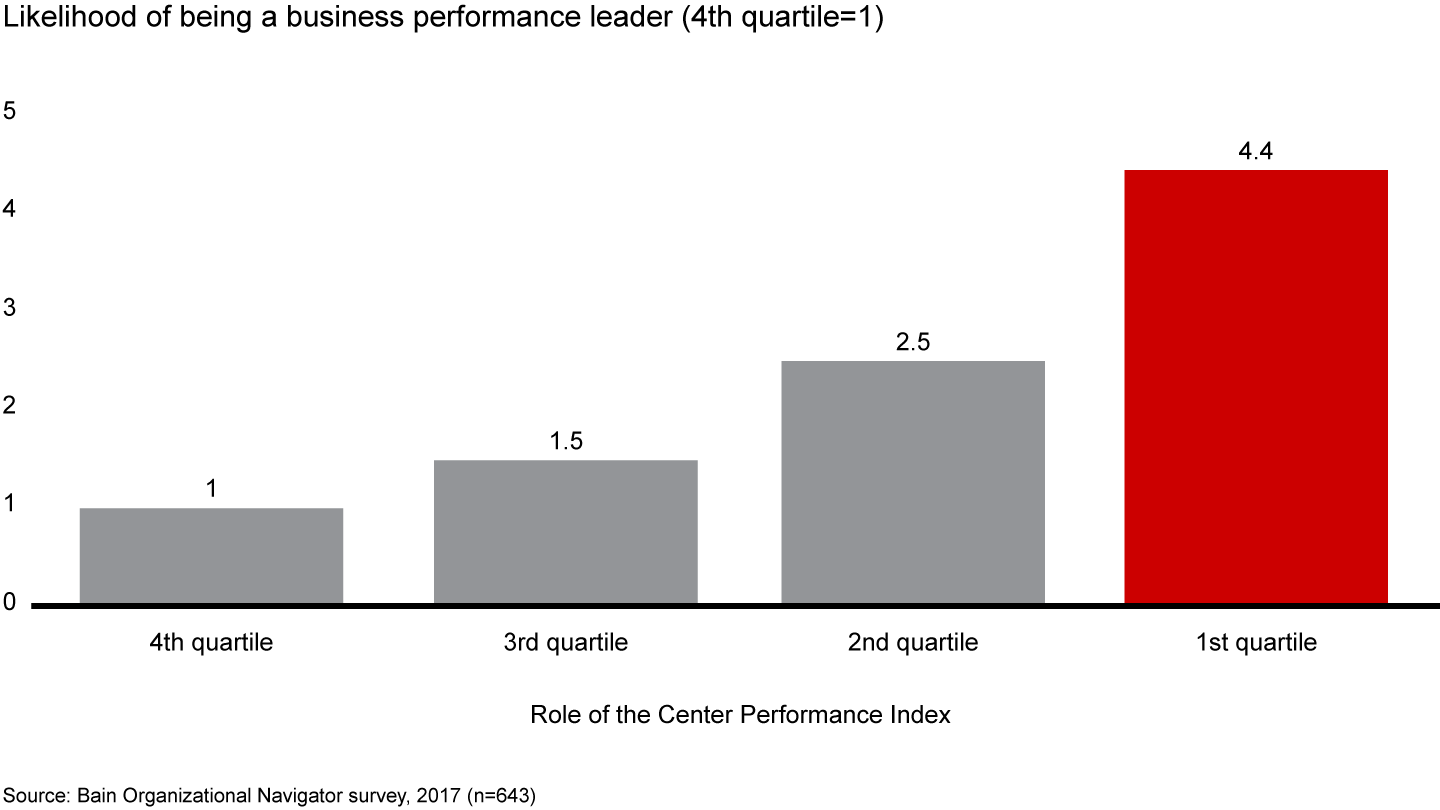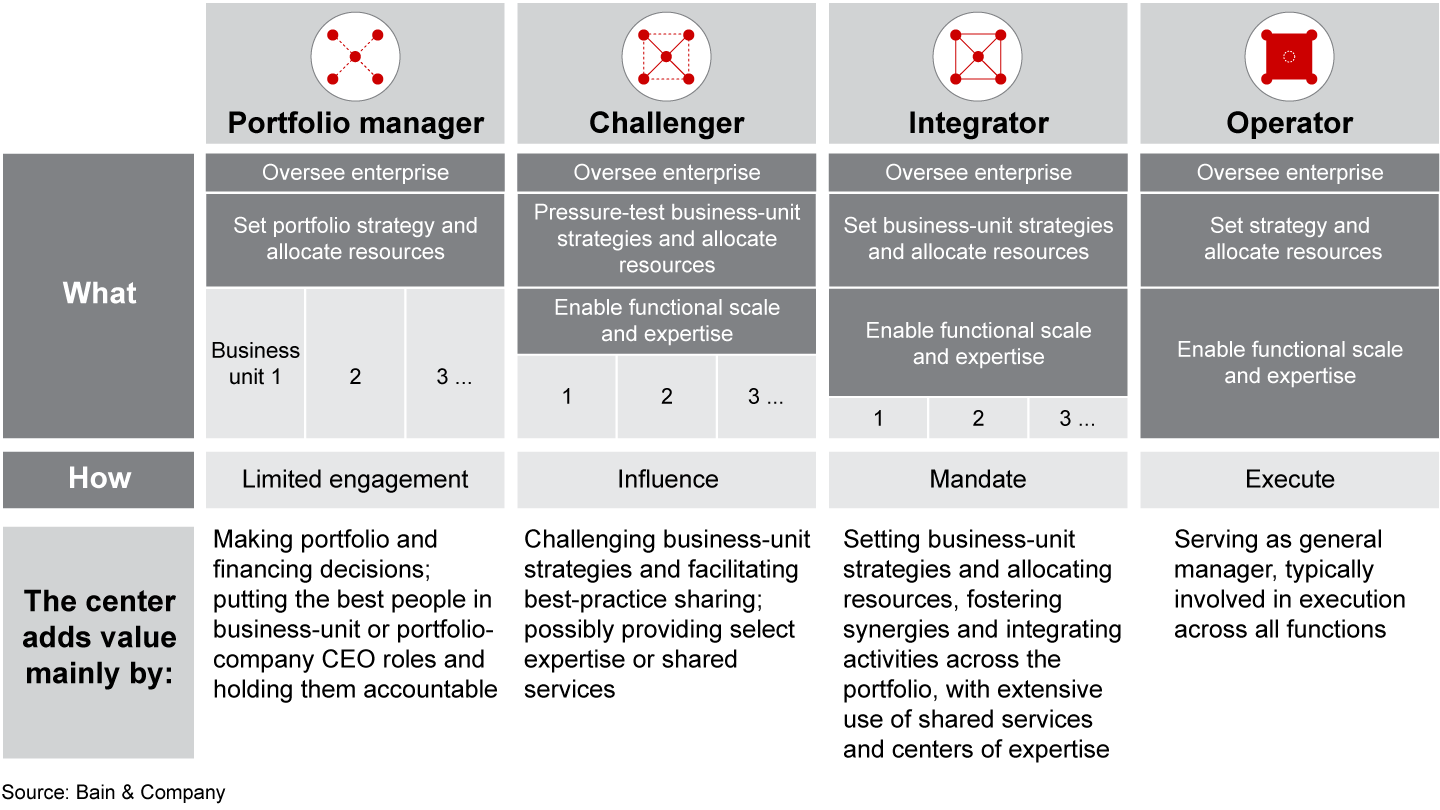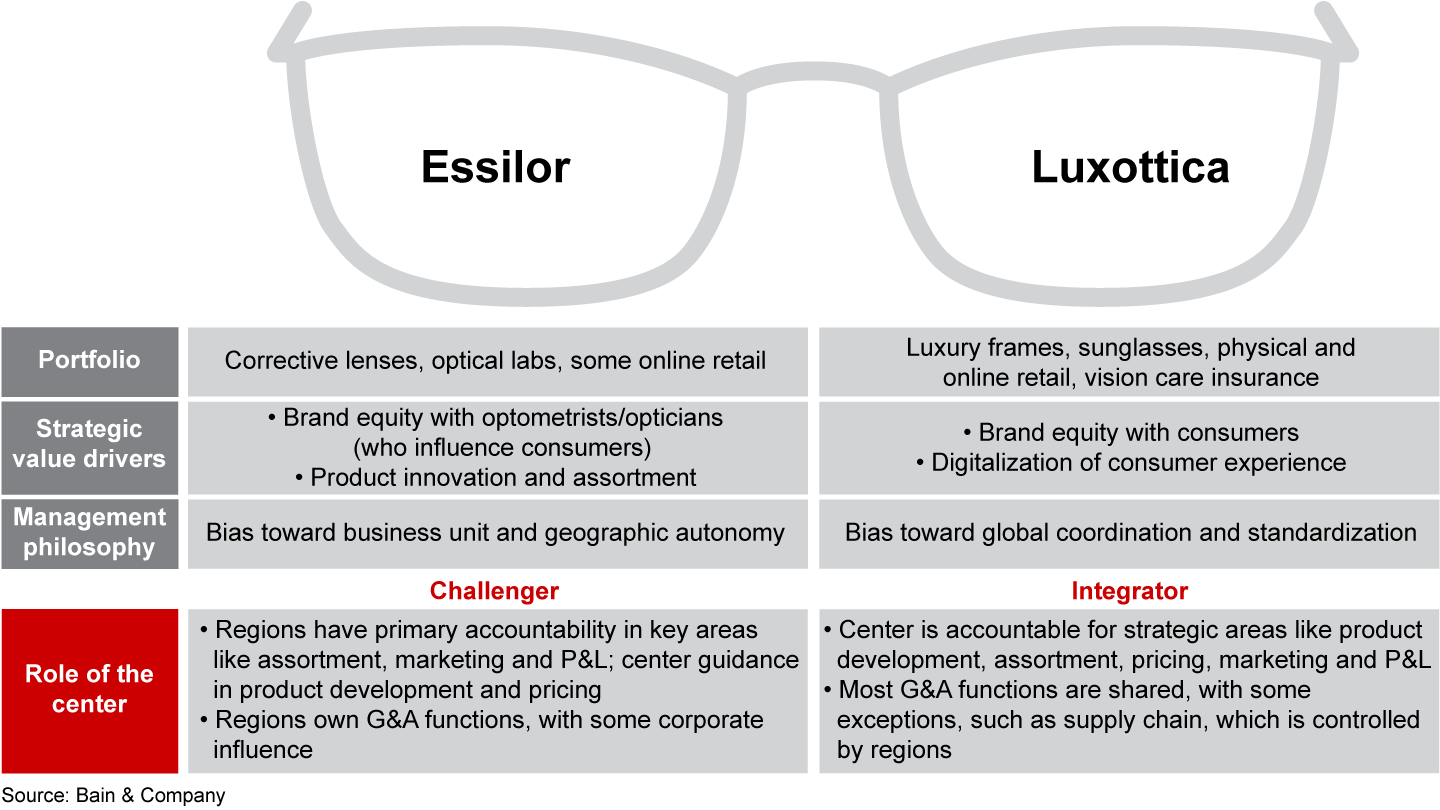論説

概要
- An organization’s center might need an overhaul when circumstances change through a strategy shift, M&A or cost pressures, or if persistent dysfunction undermines its value.
- Building a fit-for-purpose center involves two considerations: what activities and decisions the center participates in, and how the center engages with the business units.
- These choices shape four archetypes for the center: portfolio manager, challenger, integrator and operator.
- The challenger and integrator models are hardest to get right, as companies try to balance the benefit of business-unit autonomy with opportunities for cross-business synergies.
Patrick, the CEO of a transportation technology solutions firm, felt like he was caught up in a family feud. His company had been growing at a healthy clip and had just committed to an ambitious strategy that involved organic growth and acquisitions. But internal squabbling caused him to worry about the organization’s ability to meet these aspirations. Every day, it seemed, one or more of his seasoned functional leaders complained about being overwhelmed and underappreciated. His business-unit heads, on the other hand, felt underserved by “corporate” and overcharged with unnecessary corporate allocations. Patrick feared that this unresolved friction would keep the company from realizing its potential.
It’s a common predicament. No large company can be highly effective without a center that adds value—and that is perceived as valuable by people running the businesses. We take a holistic view of the center, to include not just the corporate headquarters but also any centralized resource, even if it is provided by a shared-services unit or by one business unit on behalf of others. If the role is not appropriately defined and well implemented, interactions between the center and business units can prevent a company from successfully executing ambitious strategies.
Why the center might need to change
Certain situations traditionally have caused executives to take stock of the role of the center. These range from cost pressures to a shift in strategy to unproductive tension between the center and business units. In recent years, though, several accelerating trends raise the urgency to take a fresh look at the role of the center, to determine if it needs adjustment or even a complete overhaul.
M&A for scope. Merger activity has evolved to include more deals premised on a broader scope of offerings, especially around moves up or down the value chain, or acquisitions of capabilities such as digital expertise. These deals force executives to consider whether and how the acquired business should benefit from common infrastructure across the enterprise, or how new capabilities should be integrated to deliver the anticipated value.
Copious customer data. Big data and advanced analytics tools give the corporate center new ways to stay close to customers’ priorities, while still capturing the benefits of scale. The center can potentially take a greater role in arming its front line to be highly responsive to customer needs. Many retail chains, for example, collect customer and transaction data locally but analyze it centrally to inform the structure of promotions.
Ecosystems, not assets. More firms are opening their boundaries beyond the assets they own to encompass external partnerships and broader ecosystems. With the spread of outsourcing and partnering, including cloud-based services for rent, businesses can reap the benefits of scale without providing the activity themselves. That changes the equation for which activities the center handles.
Agile at scale. As firms try to accelerate innovation by embracing Agile practices, they rely on decentralized, empowered teams. Scaling up Agile requires the center to support these teams in new ways with flexible talent systems and the right functional expertise at the right time.
Zero-based budgeting. Low-cost competitors and other cost pressures are prompting many established firms to consider zero-based budgeting, a clean-sheet approach to setting the right cost structure. Zero-basing allows executives to scrutinize all center activities to eliminate duplication and ensure that it provides only streamlined, value-adding activities.
Can the center get some love?
When companies get the role of the center right, it makes a material difference: A recent survey by Bain & Company of 643 companies, including executives from the center and the business units, found that companies that define and implement an effective role for the center are four times more likely to deliver top-quartile business performance (see Figure 1). Yet almost 40% of respondents said their center was not adding value to the business or were uncertain whether the center was providing appropriate activities more efficiently and effectively than could be done by the businesses themselves.

Designing a center that fits the company’s specific purpose involves two considerations: what activities and decisions the center participates in, and how the center engages with the businesses. From our years of working with companies to build effective centers, we see that these “what” and “how” considerations combine to shape four archetypes. The archetypes span a spectrum from narrow scope and limited engagement to broad scope and full execution: portfolio manager, challenger, integrator and operator (see Figure 2).

Companies that build their centers with care analyze several dimensions:
- How related are parts of the business portfolio? What degree of overlap is there in terms of costs, customers, capabilities and competitors?
- How does each business unit—and the center—create and sustain competitive advantage? To what extent do the businesses pursue local or market tailoring of specific offerings or processes? To what extent do they leverage global scale and standardization? What are the distinctive capabilities the parent can bring to help the business units? Do we have talent priorities or gaps that influence how we should think about the center?
- What philosophy do we use to manage the business? Do our CEO and senior team have a bias for business-unit autonomy and an entrepreneurial bent, unconstrained by the center? Or do we favor tighter coordination and control in order to reap the greatest synergies?
Four archetypes to govern by
Let’s look at each archetype in more detail, factoring in these dimensions.
Portfolio manager. Here, the center makes decisions about portfolio strategy and resource allocation, but is typically hands off when it comes to business-unit activities. It puts the best people in business-unit CEO roles and holds them accountable for the success of each business.
This model works best when the businesses are largely unrelated to each other in their sources of growth or value. The businesses should be self-sufficient in pursuing their full potential. This archetype can be relevant if the enterprise plans to spin off a specific business and, in preparation, holds it as a separate entity in the portfolio. It also applies when the stock market likely will assign more favorable valuations if there is a clear separation of business-unit results.
Many large, diversified conglomerates and private equity investors adopt this archetype, centralizing only a small subset of capabilities, if any, and making them available to the portfolio companies. KKR, for instance, taps its Capstone consulting firm to assist portfolio companies with operational improvement, but the firms are otherwise independent.
Challenger. In this archetype, business units develop their own strategies and control many of the resources to execute those plans. The center pressure-tests the businesses’ targets and strategies, actively promotes the sharing of best practices, and may provide select expertise or shared services. In general, the business-unit heads own their P&Ls and make investment trade-offs.
For the challenger archetype to work well, the businesses in the portfolio should have only limited synergies and very capable general managers. The center provides services only where it has better expertise or a lower cost than the businesses can provide on their own, creating strong pull from the business units. At Colgate-Palmolive, for example, the center focuses on product innovation and distinctive category management. Geographically defined business units, meanwhile, emphasize excellence at the ground game, with the authority to make product, marketing and supply chain decisions.
Integrator. As the name suggests, this type of center takes a firm hand in bringing together activities across the portfolio, including shared services where the business units get a lot of value. Heads of the business units own their P&Ls but may control only a subset of the components, relying on the center to deliver pooled activities.
This archetype makes sense when the business units have significant similarities in costs, customers, competitors and capabilities. The center plays a critical role in realizing synergies and enabling economies of scale, or in providing expertise that would not otherwise be available to the business units.
The 2016 merger of grocery giants Ahold and Delhaize is a case in point. Like many retailers, the combined entity decentralized numerous commercial functions to drive local brand strategies, tailor execution to the local brand’s customers and combat local competitors. However, Ahold Delhaize also built several capability centers to take advantage of its larger scale and share best practices where it mattered most, including finance, not-for-resale procurement, legal and information technology.
This new model, featuring an integrator center, enables Ahold Delhaize to better respond to local market dynamics through independent, local-brand operating units, while also delivering substantial cost synergies. The margin improvement contributes to enhanced innovation capabilities as well. For example, Ahold Delhaize recently launched its Peapod Digital Labs unit to spur digital and e-commerce innovation and technology on behalf of the local brands.
Operator. At the far end of the spectrum, the center serves as the general manager, involved in executing all functions. It is really one business; there are no business units with P&L accountabilities. Instead, these companies typically organize around functions, with activities conducted at headquarters or in local operational units.
This archetype works best when various parts of the company have similar factors underlying cost and customer value, and share a uniform set of competitors, such that the enterprise operates as one business. Functions emphasize consistent execution of activities, with some tailoring to local market conditions where appropriate. Airlines or single-banner department store chains, for instance, often operate this way.
Similar companies, different centers
Aligning on the right archetype brings welcome clarity and value to an organization. The archetype provides a coherent framework that simplifies how the center engages with the business units, balancing the benefits of standardization and efficiency with the value of business-unit autonomy. Two companies in the same industry may have good reasons to choose different roles for their centers.
Consider the case of Luxottica and Essilor, two major eyewear companies that recently merged. They compete for a share of profits in the broad vision care industry, though each operates in different parts of the value chain. Essilor makes corrective lenses and other eye care products, relying primarily on vision care professionals to promote its offerings. Luxottica predominantly makes and markets luxury frames, relying on consumer demand. Each has developed distinct sources of differentiation. Essilor prides itself on a strong distribution network, whereas Luxottica emphasizes consumer marketing and premium brands, as well as digital aspects of the customer experience.
Along with these different ways of creating value, the companies also have different management philosophies. Essilor has emphasized local decision making, with a bias toward pushing accountability to local country leaders. Luxottica has taken the opposite tack. With a strong founder-led history, the company has favored centralized, coordinated decision making.
These choices have led to different roles for their centers (see Figure 3). Essilor has been a challenger, giving significant independence to its operating companies and geographic units. Regional heads have had full accountability in key areas like assortment and marketing, with some guidance in product development and pricing, and they have owned administrative functions, with some influence from the center. Luxottica, by contrast, has been an integrator, with its center taking the lead in strategic areas such as product development, assortment, pricing and marketing.

Now that the merger is complete, leaders will have to determine how to evolve the center’s role for the combined EssilorLuxottica. Among the key questions: Which management philosophy will guide strategic decision making through the business units? When developing an offering in, say, China, or a pricing structure in the US, who decides, and how do they decide?
Where problems commonly crop up
When companies struggle with a suboptimal center, the problem sometimes stems from picking the wrong archetype for the businesses at hand. If a company has business units with only a few opportunities for synergies, yet the center plays a major role and takes a heavy hand, the center is just getting in the way. Conversely, if there are many potential synergies and a weak center, the company is leaving money on the table.
Another problem lies in choosing the right archetype but implementing it poorly—often because certain aspects of the operating model, such as behaviors or incentives, are not aligned with the center’s role. Here, the toughest issues crop up in challenger and integrator companies. Operational choices around which activities to pursue and how to engage with the business units tend to be more obvious at the extreme ends of the archetype spectrum, whereas options can be murkier for challengers and integrators.
Challengers, with their bias for business-unit autonomy, sometimes struggle to capture the relevant value across units. Challenger companies that do manage to exploit synergies apply some best practices. They collaborate closely with the business units to determine which activities to take on, based on a compelling business case. They put the internal customer’s perspective front and center, with continual feedback from the business units on how they’re performing. They partner with the business units to develop new ways to create value. Medical device manufacturer Boston Scientific, for instance, has developed a global business services unit, which works with the business units to raise service quality and efficiency by standardizing processes, automating tasks and locating work in optimal sites around the world.
Integrators have other challenges. Their attempt to capture synergies can undermine the business-unit leaders’ sense of ownership and can also slow down decision making. To deal with these risks, smart integrators take a few measures. They involve the business units in identifying where cross-unit coordination can improve performance. Because business-unit heads are accountable for the P&L but don’t control all levers, they must be able to specify the performance and cost requirements for any centralized services. They also clarify who in the organizational matrix does what, in order to avoid duplication or confusion. When decisions meet resistance, they have a clear process for resolving conflicts.
One global consumer products company encourages fast decision making for its local brands, embracing healthy conflict as a way to air important trade-offs and resolve them quickly. A country brand, for instance, uses a technique called “double hatting.” When the senior team first talks about an issue, each person represents his or her “global function hat”—supply chain, finance and so on. Then they switch hats to be owners of the brand business, asking, “What is the right answer on behalf of the brand and whole company?” Dealing with conflict in a structured way allows the brand’s team to move faster than competitors.
Questions that may trigger a center redesign
If executives wonder how much value their center adds and whether it merits an overhaul, they can address a set of key questions:
- Do we duplicate any activities, preventing us from leveraging scale for significant savings?
- Do the business units perceive value from our center commensurate with its cost?
- Is our decision making slow, or does it involve too many iterations between the center and business units?
- Have we shifted strategy in a way that requires rethinking which activities the center should perform?
- Have we struggled to retain the right caliber of talent in mission-critical roles or build expertise where it matters most?
- Do our innovation efforts change what the business units need from the center?
Like Essilor and Luxottica, companies in the same industry may compete through different strategies. But to succeed, each will need to shape a role for the center that fits the chosen business-unit portfolio, the inherent value drivers and the management philosophy like a well-tailored suit. An appropriately designed center remains a competitive advantage for large companies that take the time to choose the right archetype and sweat the details of execution.
Marcia Blenko is an advisory partner, Jenny Davis-Peccoud is a partner, Allison Gans is a partner and Ludovica Mottura is a senior director with Bain & Company’s Organization practice. They are based, respectively, in Boston, Amsterdam, New York and Boston.


